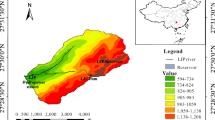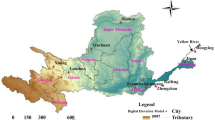Abstract
With population growth and economic development, the conflict between supply and demand of water resources is becoming more serious in recent years. In order to alleviate basin water shortage, a novel water resources allocation model which employs large-scale reservoirs to optimize water supply process is proposed in this paper. The proposed model has two conflicting objectives that are the minimization of the total water supply shortfall and the maximization of the total power generation. Because of the huge system scale and numerous constraints, water resources optimal allocation (WROA) is a high dimensional, coupled and nonlinear problem. An improved hybrid optimal method which combines decomposition coordination (DC) and discrete differential dynamic programming (DDDP) is developed to optimize the complex problem. An adaptive bias corridor technology is presented to improve convergence speed during subsystem optimization. Finally, the proposed optimal model and the hybrid method are applied to the water resources allocation in the upper reaches of Yangtze River. The results indicate that the proposed model not only can reduce the total water supply shortfall effectively but also can improve the total power generation.



Similar content being viewed by others
References
Abed-Elmdoust A, Kerachian R (2012) Water resources allocation using a cooperative game with fuzzy payoffs and fuzzy coalitions. Water Resour Manag 26:3961–3976
Ashofteh PS, Haddad OB, Mariño MA (2012) Climate change impact on reservoir performance indexes in agricultural water supply. J Irrig Drain Eng 139:85–97
Babel M, Gupta AD, Nayak D (2005) A model for optimal allocation of water to competing demands. Water Resour Manag 19:693–712
Bielsa J, Duarte R (2001) An economic model for water allocation in north eastern Spain. Int J Water Resour Dev 17:397–408
Bielsa J, Duarte R (2002) Modelling water resource allocation: a case study on agriculture versus hydropower production. In: Economics of Sustainable Energy in Agriculture. Springer, 157–175
Chang J, Bai T, Huang Q, Yang D (2013) Optimization of water resources utilization by PSO-GA. Water Resour Manag 27:3525–3540
Chen J, Guo S, Li Y, Liu P, Zhou Y (2013) Joint operation and dynamic control of flood limiting water levels for cascade reservoirs. Water Resour Manag 27:749–763
Cheng C, Wang S, Chau K-W, Wu X (2014) Parallel discrete differential dynamic programming for multireservoir operation. Environ Model Software 57:152–164
Collet L, Ruelland D, Borrell-Estupina V, Servat E (2013) Assessing the long-term impact of climatic variability and human activities on the water resources of a meso-scale Mediterranean catchment. Hydrol Sci J
Goyal MK, Ojha C, Singh R, Swamee P, Nema R (2013) Application of ANN, fuzzy logic and decision tree algorithms for the development of reservoir operating rules. Water Resour Manag 27:911–925
Guo X, Hu T, Zhang T, Lv Y (2012) Bilevel model for multi-reservoir operating policy in inter-basin water transfer-supply project. J Hydrol 424:252–263
Haddeland I et al (2014) Global water resources affected by human interventions and climate change. Proc Natl Acad Sci 111:3251–3256
Han Y, Xu S-G, Xu X-Z (2008) Modeling multisource multiuser water resources allocation. Water Resour Manag 22:911–923
Han Y, Huang Y-F, Wang G-Q, Maqsood I (2011) A multi-objective linear programming model with interval parameters for water resources allocation in Dalian city. Water Resour Manag 25:449–463
Heidari M, Chow VT, Kokotović PV, Meredith DD (1971) Discrete differential dynamic programing approach to water resources systems optimization. Water Resour Res 7:273–282
Higgins A, Archer A, Hajkowicz S (2008) A stochastic non-linear programming model for a multi-period water resource allocation with multiple objectives. Water Resour Manag 22:1445–1460
Hsu N-S, Chiang C-H, Cheng W-M, Wei C-C (2012) Study on the trade-off between ecological base flow and optimized water supply. Water Resour Manag 26:3095–3112
Huang W, Zhang X, Li C, Wang J (2011) A multi-layer dynamic model for coordination based group decision making in water resource allocation and scheduling. In: Intelligent Computing and Information Science. Springer, 148–153
Huang Y, Li Y, Chen X, Bao A, Ma Y (2013) A multistage simulation-based optimization model for water resources management in Tarim River Basin, China. Stoch Env Res Risk A 27:147–158
Jinfeng W, Jilei W, Zhiyong W, Changming L, Jingjie Y (2004) An optimized spatial-temporal-sectoral allocation model for water resources. GeoJournal 59:227–236
Li C, Zhou J, Ouyang S, Ding X, Chen L (2014) Improved decomposition–coordination and discrete differential dynamic programming for optimization of large-scale hydropower system. Energy Convers Manag 84:363–373
Liu D, Chen X, Lou Z (2010) A model for the optimal allocation of water resources in a saltwater intrusion area: a case study in Pearl River Delta in China. Water Resour Manag 24:63–81
Morankar D, Raju KS, Kumar DN (2013) Integrated sustainable irrigation planning with multiobjective fuzzy optimization approach. Water Resour Manag 27:3981–4004
Raul SK, Panda SN (2013) Simulation-optimization modeling for conjunctive use management under hydrological uncertainty. Water Resour Manag 27:1323–1350
Reis L, Bessler F, Walters G, Savic D (2006) Water supply reservoir operation by combined genetic algorithm–linear programming (GA-LP) approach. Water Resour Manag 20:227–255
Sadegh M, Kerachian R (2011) Water resources allocation using solution concepts of fuzzy cooperative games: fuzzy least core and fuzzy weak least core. Water Resour Manag 25:2543–2573
Shao W, Yang D, Hu H, Sanbongi K (2009) Water resources allocation considering the water use flexible limit to water shortage—a case study in the Yellow River Basin of China. Water Resour Manag 23:869–880
Singh A, Panda SN (2013) Optimization and simulation modelling for managing the problems of water resources. Water Resour Manag 27:3421–3431
Tang D (1995) Optimal allocation of water resources in large river basins: I. Theory. Water Resour Manag 9:39–51
Tospornsampan J, Kita I, Ishii M, Kitamura Y (2005) Optimization of a multiple reservoir system operation using a combination of genetic algorithm and discrete differential dynamic programming: a case study in Mae Klong system, Thailand. Paddy Water Environ 3:29–38
Vasan A, Raju KS (2007) Application of differential evolution for irrigation planning: an Indian case study. Water Resour Manag 21:1393–1407
Vieira J et al (2010) Optimization of the operation of large-scale multisource water-supply systems. J Water Resour Plan Manag 137:150–161
Wang L, Fang L, Hipel KW (2008) Basin-wide cooperative water resources allocation. Eur J Oper Res 190:798–817
Xu J, Tu Y, Zeng Z (2012) Bilevel optimization of regional water resources allocation problem under fuzzy random environment. J Water Resour Plan Manag 139:246–264
Yakowitz S (1982) Dynamic programming applications in water resources. Water Resour Res 18:673–696
Yang C-C, Chang L-C, Chen C-S, Yeh M-S (2009) Multi-objective planning for conjunctive use of surface and subsurface water using genetic algorithm and dynamics programming. Water Resour Manag 23:417–437
Yen J, Chen C-Y (2001) Allocation strategy analysis of water resources in South Taiwan. Water Resour Manag 15:283–297
Zhang L, Li C (2014) An inexact two-stage water resources allocation model for sustainable development and management under uncertainty. Water Resour Manag 1–18
Zheng J, Yang K, Hao Y (2012) Multi-objective decomposition-coordination for mix-connected hydropower system load distribution. Procedia Eng 28:210–213
Acknowledgments
This work is funded by the National Natural Science Foundation Key Project of China (51239004), and is also funded by the National Natural Science Foundation of China (51309105) and CRSRI Open Research Program (CKWV2014220/KY).
Author information
Authors and Affiliations
Corresponding authors
Rights and permissions
About this article
Cite this article
Li, C., Zhou, J., Ouyang, S. et al. Water Resources Optimal Allocation Based on Large-scale Reservoirs in the Upper Reaches of Yangtze River. Water Resour Manage 29, 2171–2187 (2015). https://doi.org/10.1007/s11269-015-0934-x
Received:
Accepted:
Published:
Issue Date:
DOI: https://doi.org/10.1007/s11269-015-0934-x




